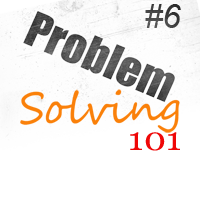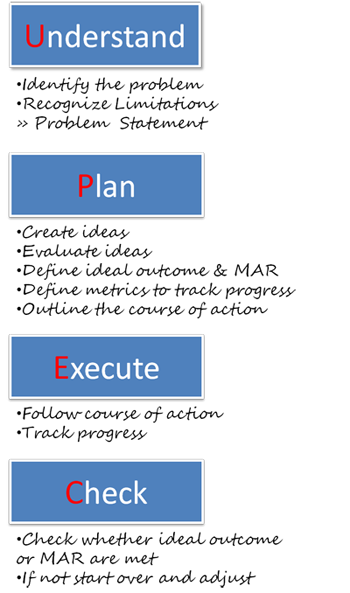 The acronym of the problem solving process in this course is UPEC (Understand, Plan, Execute, and Check). In this lesson I want to talk about the last stage: “Check”.
The acronym of the problem solving process in this course is UPEC (Understand, Plan, Execute, and Check). In this lesson I want to talk about the last stage: “Check”.
You may wonder why I even have to write a separate post about that stage. It seems so obvious. You are done when the problem is solved, what is there to check?
Well, first of all, if you’ve done everything perfectly the check would be the point in time when you actually acknowledge that you are done. That’s a great moment worth noticing, isn’t it?
However as you may guess, again, things are often not that easy if you want to do them right. Even the simplest problem may have more to it than you think.
The Process (again)
 Let me give a very simple example. The situation:
Let me give a very simple example. The situation:
While you are watching your favorite show your TV goes black.
You realize that the power in the entire house is gone, so you check the fuse box and notice the main switch was off. You switch it back on, and all the lights are back as well as your TV. Check passed (?).
Of course that may have solved the problem, but chances are good there was a reason for the main fuse to blow out. Some appliance may be faulty and have created a peak charge which triggered the fuse. Now this appliance may be off or on stand-by. In this case you could not say the problem is really solved. There may be a bigger problem that needs solving.
This is why I emphasized the initial problem assessment because understanding the dimensions and limitations of our problem are crucial for us to be happy with the solution. I mentioned in Execute and Measure how important it is to measure the right metrics to make sure we don’t create new problems. However even the best metrics don’t help if we are solving the wrong problems. This is where a thorough and honest assessment of the situation in the end is equally important. The TV was just an example, think about all sorts of problems you can run into.
One check solutions?
 I want to give a personal example here if you don’t mind. It is probably no exaggeration to assume maintaining a healthy lifestyle is something many of us who spent so many hours sitting behind a computer screen struggle with. Actually, I guess it doesn’t matter where you are sitting all day for that matter.
I want to give a personal example here if you don’t mind. It is probably no exaggeration to assume maintaining a healthy lifestyle is something many of us who spent so many hours sitting behind a computer screen struggle with. Actually, I guess it doesn’t matter where you are sitting all day for that matter.
Anyway, my level of fitness reached a point where I couldn’t pretend there wasn’t a problem anymore. For most days, the best exercise I got was the walk from the car to the office. I’ve tried to follow my own “workout program” without success. Yes, I put it in parenthesis for a reason. I was also too proud get an exercise program designed by my wife who is a life coach. She kept bugging me, though. I’ve done enough sport in my life to know what I have to do, was one excuse. I knew how to organize and didn’t need anyone’s help was another.
To make the story short, she gave me the Insanity workout program; I got up every morning at 5 AM, squatted, jumped, and kicked myself into insanity for 60 days, without missing out a single day. I had lost weight and felt much better. But my wife already knew what I slowly realized back then: My problem was not solved at all. I still wasn’t in the shape I wanted to be in and would not get there just doing this same workout over and over again. Even more importantly, without regular workout (every week) and healthy eating habits (I love burgers) I will never be able to maintain what I consider a healthy lifestyle.
I know, this is a lot of talk just to point out that for some problems the tracking and checking never ends. As simple this insight may seem, it is so often forgotten as much in private life as it is in business.
These are the problems in life that are often solved by taking up new habits. Habits are tough to change; I can tell you…
In business, these are are implemented through routines within operation procedures. Changing was done a certain way for a long time also requires quite some effort and goodwill by everyone involved.
Ideal Outcome and MAR
But how do I check at the end of the year whether I have reached my goal? The ideal outcome is, when at the end of the year I will look back and have exercised three times every single week for at least 180 minutes total. Since I track workout minutes and exercise units per week, only one week with less than that means, I failed. Do you agree?
If I miss out on one workout in a year, I will still be much better off than without any exercise. However where do I draw the line? What if I figure out that I rather work out six days a week for 30 minutes than three times for 60? This is where the MAR, the Minimal Acceptable Result, comes in. Since I track two metrics, I defined two MARs, the number of exercise minutes and the number of days I exercised per period of 7 days. I am fine as long as I reach 80% fulfillment on both. Tracking both makes sure I don’t cheat either on the time or the number. For example, running once every week for three hours wouldn’t do it. I made a spreadsheet to track my progress. If you are interested, you can download my Exercise Tracking Excel worksheet.
Every month I will re-evaluate (check!) the plan as well as the MAR. It could be that after two months even I think with 80% I am too lenient with myself. Or I’ll realize it doesn’t solve my problem at all.
The Take Away
The “Check” is the conscious act of assessing where you are in your problem solving process. This means you look at your metrics and decide in regular intervals whether you are still within the success range as framed by ideal outcome and MAR. This allows you to correct the plan you had, which may even make it necessary to re-define the problem. It is not a bad thing to acknowledge consciously when everything goes according to plan. Mourn your losses but also celebrate your wins!
The final check occurs at the end of your course of action. You assess whether
1) the problem is solved per your definition
2) the solution fits in the big picture or
3) new problems where created or
4) there are other overarching or residual problems
5) the solution is sustainable
The answers to all these questions will dictate whether you are really done (celebrate!) or further action is needed.
[ois skin=”subscribe 2 no AL”]
The Problem Solving Series
So far these lessons of the Problem Solving 101 course have been published:
- Lesson 1: Introduction
- Lesson 2: Understanding Your Problem
- Lesson 3: Planing Solutions Part 1
- Lesson 4: Execute and Measure
- Lesson 5: The Big Why
- Lesson 6: No Checks, No Glory (this lesson)
- Lesson 7: Creating Ideas
- Lesson 8: The Value of Testing Everything
- Lesson 9: The Failure Game